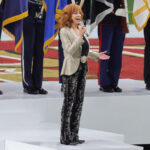“Mary’s Song (Oh My, My, My)” from Taylor Swift’s debut album has captured hearts for years with its sweet and nostalgic narrative. This track stands out as a testament to enduring love, childhood innocence, and Swift’s early storytelling prowess. Let’s delve into the “Mary’s Song lyrics” to uncover the deeper meaning behind this beloved song and explore why it continues to resonate with listeners today.
“Mary’s Song”: A Childhood Love Story
“Mary’s Song” unfolds as a charming narrative of a love that blossoms from childhood friendship into a lifelong romance. The song tells the story of two individuals growing up side-by-side in their hometown, navigating the stages of life together. It’s a nostalgic reflection on simpler times, the magic of young love, and the hope that some bonds truly are unbreakable. The setting is clearly rooted in small-town America, evoking a sense of intimacy and close-knit community that frames the central relationship.
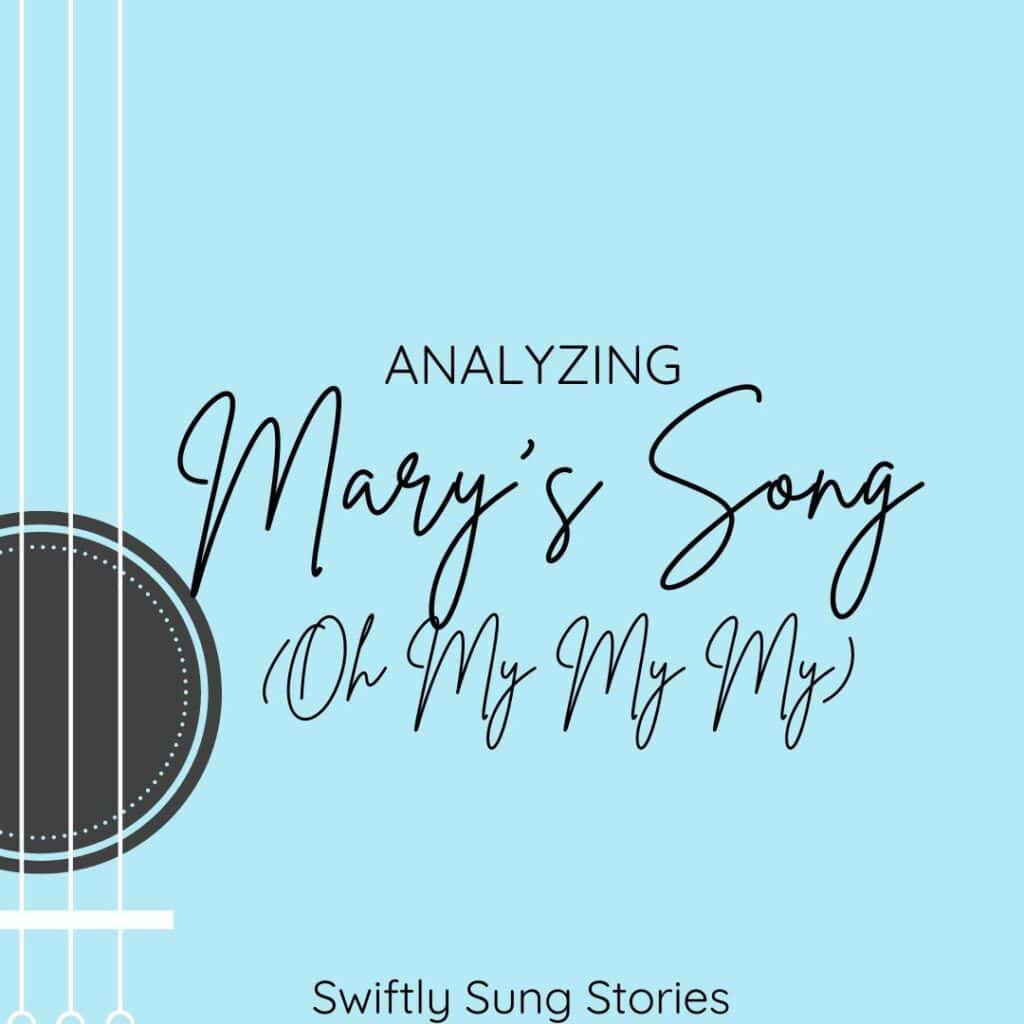 Taylor Swift lyrical analysis cover image
Taylor Swift lyrical analysis cover image
The song’s structure itself contributes to its storytelling. It begins with a third-person perspective, setting the scene and introducing the characters, before shifting to a first-person perspective, drawing the listener into the narrator’s personal feelings and memories. This shift in perspective allows for both a broader overview of the relationship and an intimate glimpse into the narrator’s heart. The song progresses chronologically through their lives, marked by key moments and evolving emotions, creating a complete narrative arc within its verses and choruses.
Line-by-Line Lyric Analysis of “Mary’s Song”
To truly appreciate the depth of “Mary’s Song”, let’s break down the lyrics verse by verse, chorus by chorus, and explore the nuances of Taylor Swift’s storytelling.
Verse 1: “She said I was seven and you were nine”
The song opens with a nostalgic flashback to childhood. “She said I was seven and you were nine / I looked at you like the stars that shined.” This establishes the initial innocence and wonder of young admiration. The “stars that shined” metaphor highlights the boy’s specialness in the girl’s eyes and sets a romantic, almost fairytale-like tone from the beginning. The lyrics continue, “The pretty lights in your eyes, and I saw the pretty lights / And our daddies used to joke about us gettin’ married.” “Pretty lights” reinforces the initial sparkle and attraction, suggesting a mutual connection. The fathers’ joking about marriage foreshadows the enduring nature of their relationship, even as children. The verse concludes with, “And our mamas said we laughed way too loud / And our daddies used to joke about us gettin’ married / Oh, my, my, my.” The mothers’ reaction, “laughed way too loud,” adds a touch of realism and youthful exuberance. “Oh, my, my, my” expresses a mix of disbelief and amusement at the fathers’ jokes, highlighting the naivety of childhood perceptions of love and marriage.
Chorus: “Take me back to the time when our world was one block wide”
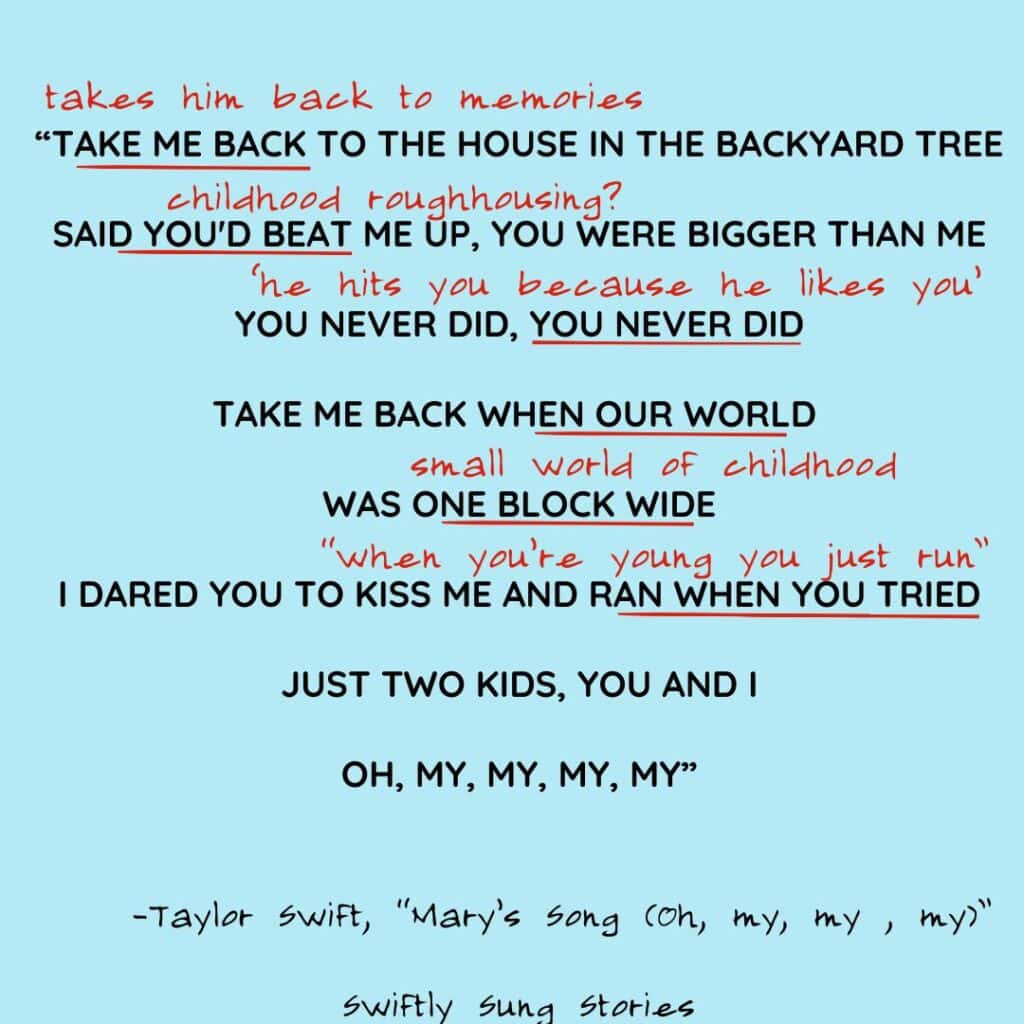 Visual lyric analysis of Taylor Swift's Mary's Song chorus
Visual lyric analysis of Taylor Swift's Mary's Song chorus
The chorus serves as a powerful emotional anchor, emphasizing the theme of nostalgia and simpler times. “Take me back to the time when our world was one block wide / And I dared you to kiss me and ran away when you tried.” This paints a vivid picture of childhood innocence and playful interactions. “Our world was one block wide” symbolizes the limited scope of their childhood world, where their entire universe revolved around their neighborhood and each other. The line about daring a kiss and running away captures the typical shyness and playful teasing of young children experiencing budding romantic feelings. “Just two kids, you and I, oh my, my, my / Take me back to the time when our world was one block wide.” The repetition of “just two kids, you and I” reinforces their youth and shared experiences. “Oh, my, my, my” in the chorus carries a longing for these simpler times, a wistful reflection on the past.
Verse 2: “We were sixteen and driving around town”
Verse 2 marks a time jump to their teenage years. “We were sixteen and driving around town / I suddenly wasn’t that little girl you used to see.” This signifies a transition from childhood to adolescence, with physical and emotional changes. “Suddenly wasn’t that little girl” highlights the narrator’s awareness of growing up and being perceived differently. “But your eyes still shined like pretty lights when you laughed / My father said he never thought it’d last.” Despite the changes, the “pretty lights” in his eyes remain, a consistent symbol of their connection. The father’s doubt, “never thought it’d last,” introduces a hint of external skepticism towards their young love. “And our mamas rolled their eyes / Said, ‘Oh my, my, my’.” The mothers’ “rolled their eyes” reaction is different here. It’s less dismissive and perhaps more concerned, hinting at the complexities and potential heartbreaks of teenage romance. “Oh, my, my, my” in this context suggests a sense of mild worry or resignation from the mothers, acknowledging the unpredictable nature of young love.
Chorus 2: “Slammin’ screen doors and highway signs”
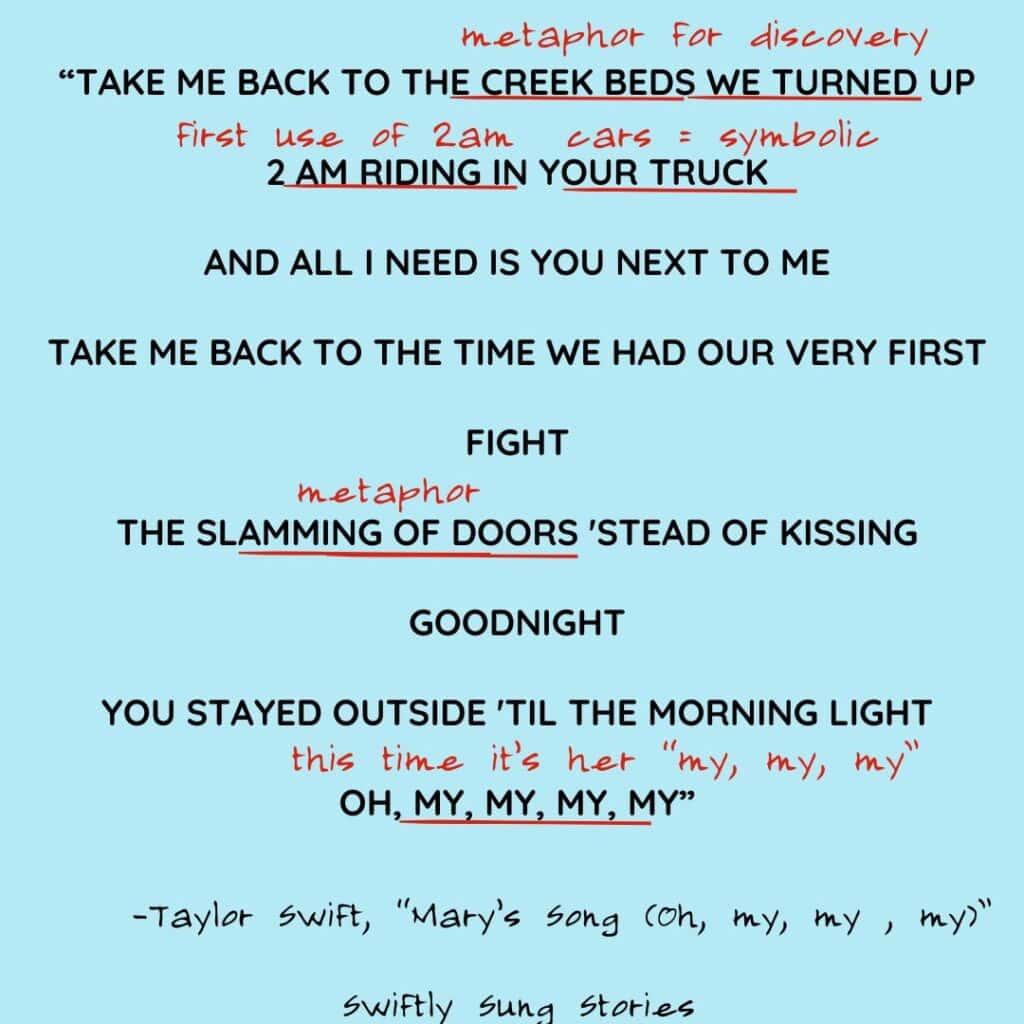 Lyrical analysis of Mary's Song's meaning in Taylor Swift's discography
Lyrical analysis of Mary's Song's meaning in Taylor Swift's discography
The second chorus reflects the teenage years and the intensity of young relationships. “Take me back to the creek beds we used to roam / 2 AM ridin’ in your truck with the radio on.” “Creek beds we used to roam” further evokes nostalgic imagery of their shared childhood adventures. “2 AM ridin’ in your truck” is a classic symbol of teenage freedom and late-night romance, a recurring motif in Taylor Swift’s songs. “Slammin’ screen doors and highway signs / You said, ‘I know you, and you know I do’.” “Slammin’ screen doors” suggests teenage arguments and emotional outbursts, the drama of young love. “Highway signs” represents the wider world they are beginning to explore together, beyond their “one block wide” childhood world. “You said, ‘I know you, and you know I do'” is a powerful declaration of deep understanding and connection amidst the teenage turmoil. “Just two kids, you and I, oh my, my, my / Take me back to the time when we walked down main street.” Again, “just two kids, you and I” emphasizes their enduring bond through these turbulent years. “Walked down main street” brings back the small-town setting and shared experiences as they navigate adolescence together.
Verse 3: “We got no room to slow down”
Verse 3 marks another time jump, moving into adulthood and commitment. “We got no room to slow down / He knelt to the ground and pulled out a ring.” This signifies a significant step in their relationship – engagement and a commitment to marriage. “And said, ‘Marry me, Juliet’ / You’ll never have to be lonely’.” The “Marry me, Juliet” line is a romantic and slightly dramatic proposal, referencing Romeo and Juliet but with a promise of a happier ending. “You’ll never have to be lonely” is a heartfelt promise of companionship and lifelong love. “And I said, ‘Yes’ runnin’ up the stairs / And our mamas cried.” Her enthusiastic “Yes” and “runnin’ up the stairs” conveys her joy and excitement. “Our mamas cried” shows the emotional depth of this moment, with the mothers’ tears now tears of happiness and validation, a stark contrast to their earlier reactions. “Oh, my, my, my.” “Oh, my, my, my” here expresses overwhelming joy and disbelief at the realization of their lifelong dream coming true.
Chorus 3: “Take me back to the porch lights and iced tea”
 Visual analysis of Taylor Swift's Mary's Song lyrics and meaning
Visual analysis of Taylor Swift's Mary's Song lyrics and meaning
The final chorus brings the narrative full circle, envisioning their future together in their hometown. “Take me back to the porch lights and iced tea / And everything was quiet and slow.” “Porch lights and iced tea” evokes a serene and domestic image of home and simple pleasures, representing a comfortable and lasting love. “Everything was quiet and slow” contrasts with the earlier fast-paced stages of their relationship, suggesting a peaceful and settled future. “Just two kids, you and I, oh my, my, my / Take me back to the time when we had our whole lives ahead of us.” “Just two kids, you and I” remains a constant, highlighting the enduring nature of their bond from childhood to old age. “Whole lives ahead of us” now carries a sense of fulfillment, as they have built a life together starting from those early days. “Oh, my, my, my” in this final chorus expresses contentment and gratitude for the journey they have shared and the future they have built.
Outro: “I’ll be eighty-seven, you’ll be eighty-nine”
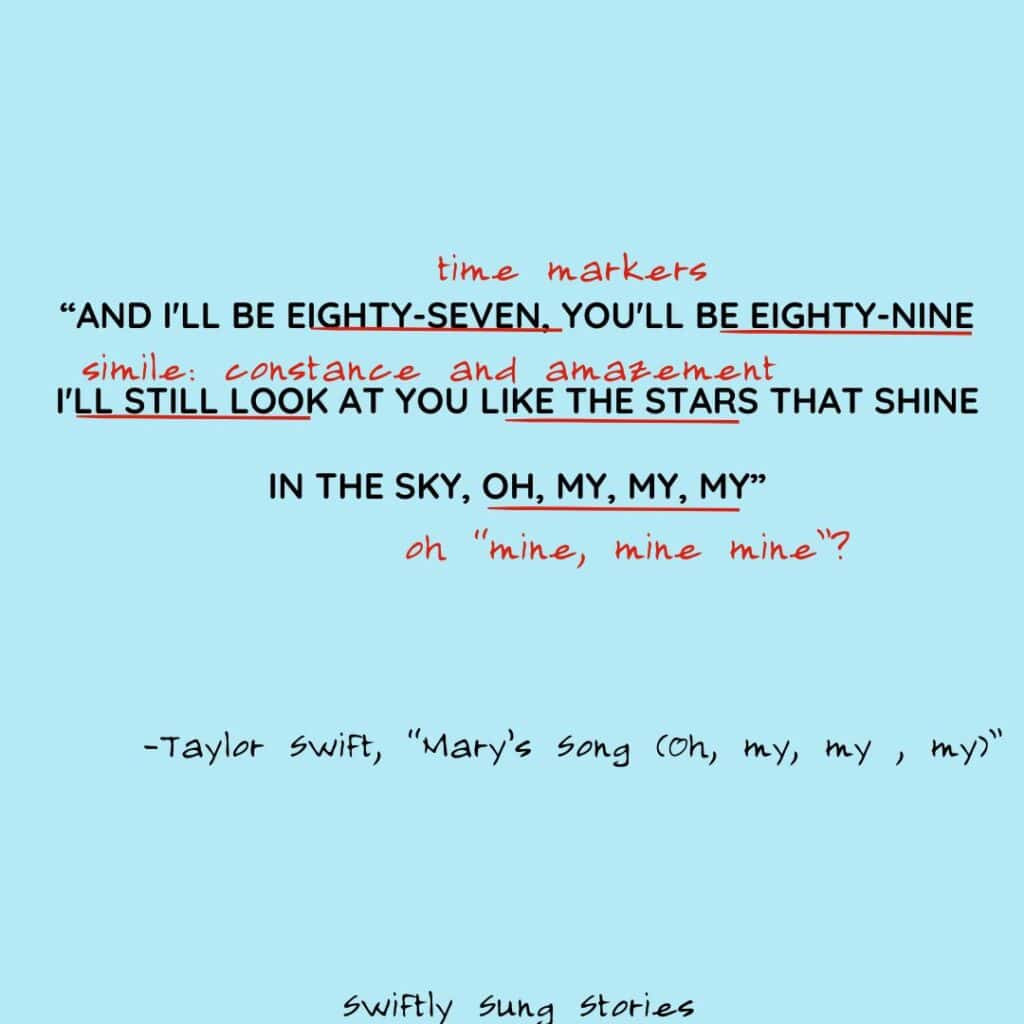 Taylor Swift 87 89 lyrics analysis from Mary's Song
Taylor Swift 87 89 lyrics analysis from Mary's Song
The outro extends the narrative to their old age, emphasizing the enduring nature of their love. “I’ll be eighty-seven, you’ll be eighty-nine / I’ll still look at you like the stars that shine.” This directly references the opening lines and reinforces the idea that her admiration and love will remain constant throughout their lives, even into old age. The specific ages, “eighty-seven” and “eighty-nine,” add a touch of realism and specificity to their envisioned future. “In the stories that we write / In the stories that we write / You’ll be eighty-seven, I’ll be eighty-nine / I’ll still look at you like the stars that shine / Oh, my, my, my.” The repetition of “in the stories that we write” suggests that their lives together are a story being written and lived, a testament to their enduring love. The final “Oh, my, my, my” serves as a gentle and heartfelt sigh of contentment and wonder at the long and beautiful life they have shared.
Themes and Significance of “Mary’s Song”
“Mary’s Song” is rich with thematic depth, exploring several universal and relatable concepts.
- Enduring Love: The central theme is the enduring nature of true love that lasts from childhood through old age, defying skepticism and life’s challenges.
- Nostalgia and Simpler Times: The song evokes a strong sense of nostalgia for childhood innocence and the simpler world of youth, a common theme in Taylor Swift’s early work.
- Narrative Storytelling: “Mary’s Song” is a prime example of Swift’s narrative songwriting, creating a complete and engaging story within a song format, showcasing her early talent for character development and plot progression in her lyrics.
- Childhood to Adulthood: The song beautifully captures the journey from childhood friendship to adult romance, highlighting the evolution of their relationship through different life stages.
- Small-Town America: The setting of a small town plays a crucial role, emphasizing community, shared history, and the intimacy of their relationship within a familiar environment.
The “87 and ’89” Connection: Travis Kelce and Fan Theories
The outro’s lyrics, “I’ll be eighty-seven, you’ll be eighty-nine,” have recently gained renewed attention due to Taylor Swift’s relationship with Travis Kelce. Travis Kelce’s jersey number is 87, and Taylor Swift was born in 1989. This numerical coincidence has fueled fan theories suggesting that “Mary’s Song” might have been a form of manifestation or foreshadowing of her current relationship. While purely speculative, this connection has added an extra layer of intrigue and contemporary relevance to the song for many fans.
Why “Mary’s Song” Still Resonates
“Mary’s Song” continues to resonate with listeners for several reasons:
- Relatable Narrative: The story of childhood sweethearts and enduring love is a universally appealing and heartwarming narrative.
- Nostalgic Charm: The song’s nostalgic elements evoke a longing for simpler times and the innocence of youth, tapping into a common human sentiment.
- Taylor Swift’s Storytelling: It showcases Swift’s early talent for detailed and engaging storytelling, drawing listeners into the characters’ lives and emotions.
- Hopeful Message: In a world often marked by fleeting relationships, “Mary’s Song” offers a hopeful message about the possibility of lasting love and commitment.
“Mary’s Song (Oh My, My, My)” is more than just a sweet song; it’s a beautifully crafted narrative about enduring love, childhood memories, and the timeless appeal of a classic love story. Its enduring popularity is a testament to Taylor Swift’s songwriting talent and the universal desire for lasting connection and love that stands the test of time.

